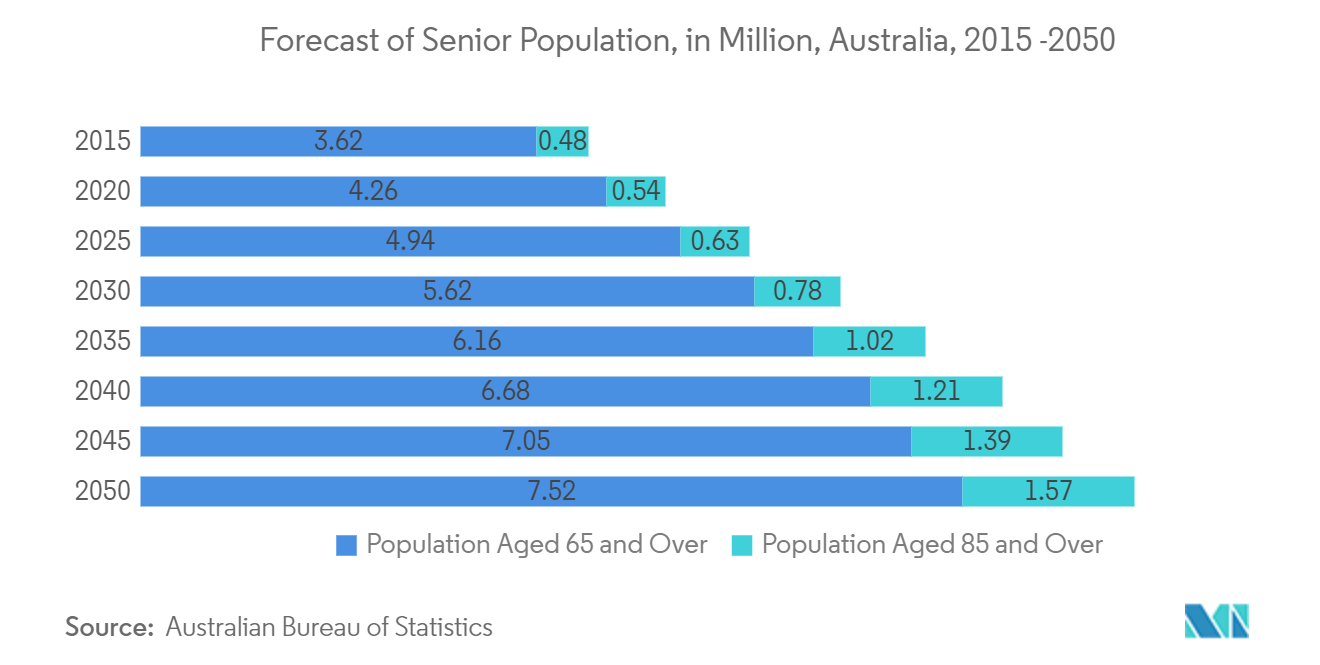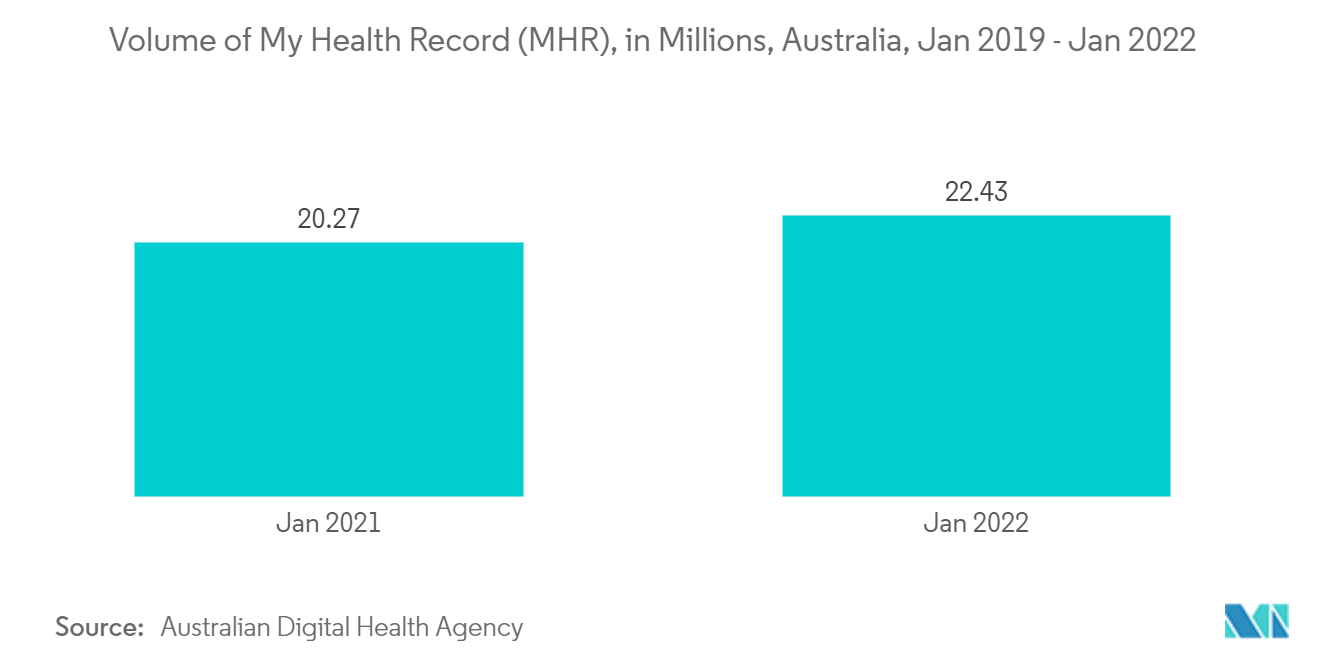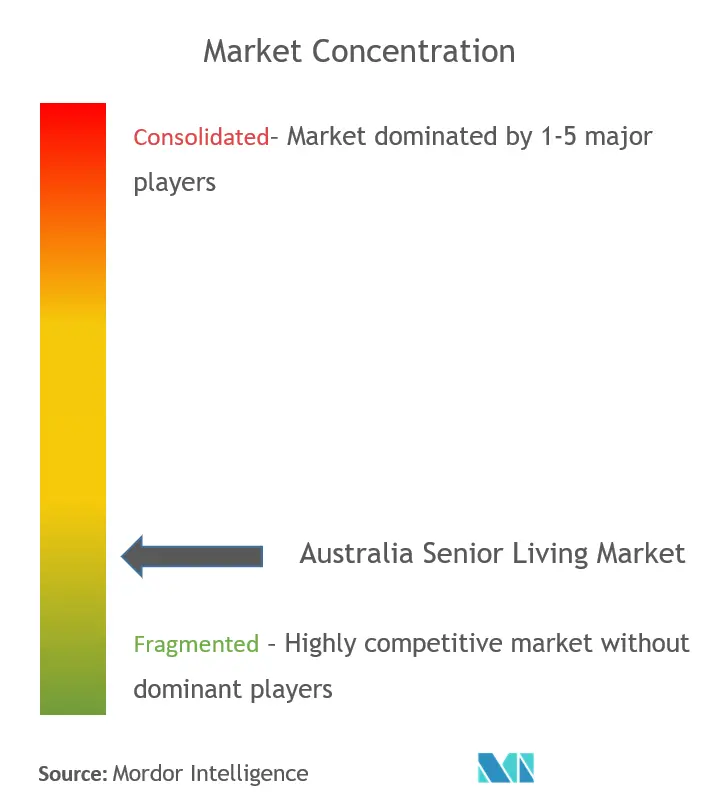Australia Senior Living Market Analysis
The Australia Senior Living Market size is estimated at USD 6.52 billion in 2025, and is expected to reach USD 9.66 billion by 2030, at a CAGR of 8.17% during the forecast period (2025-2030).
The housing demand from the aging population drives the market. Furthermore, the market is driven by the demand for multi-story buildings.
- The demand for senior housing has increased in Australia due to the COVID-19 pandemic. It is expected to continue to rise in the coming years, driven by a focus on health and well-being and a rapidly aging population. Real estate developers respond to this demand by constructing standalone senior living projects or dedicated towers with necessary amenities for senior citizens within a larger group housing project.
- According to the Property Council of Australia's 2021 Retirement Living Census, multi-story buildings are becoming more common in retirement villages. According to the report, 41% of new towns in 2020-21 were classified as 'vertical' in nature, up from 33% in 2020. Furthermore, retirees are increasingly seeking locations near the bustling, vibrant urban village ton access restaurants, shopping malls, and arts and cultural opportunities.
- Land in and around these areas is frequently set aside for higher-density living, taken advantage of by retirement village developers. As of 2022, 13 higher-density projects are currently under construction or have recently been completed, given the strong trend toward vertical retirement villages. Some projects feature multimillion-dollar apartments, while others have units for under USD 300,000.
Australia Senior Living Market Trends
Increasing Senior Population and Life Expectancy driving the market
- Around a quarter of Australians will be 65 or older in 27 years, with the proportion of younger Australians declining. In two years, the number of people aged 65 and above will have surpassed the number of children aged 0 to 14. There are twice as many women as men aged 85 and above, reflecting their longer life expectancy. The number of Australians aged 85 and over is expected to rise from 540,000 in 2020 to 1.57 million in 27 years.
- One in every three Australians over 65 comes from various cultural and linguistic backgrounds. Around 840,000 Australians aged 65 and above were born in another country. Australians have one of the world's longest life expectancies. Men live nearly 80 years, and women live 84 years, 25 years longer than a century ago. The physical health of older Australians is also improving, and most people (82%) are satisfied with their standard of living.
- Most older Australians live independently at home — only one in every four people over 85 lives in a care accommodation. Compared to previous generations, rates of volunteering among the "baby boomer" generation – recently retired, healthy, and inclined to give back to their communities - continue to rise.
Adoption of Electronic Health Records (EHR) Driving the Market
- As of January 2022, more than 23.2 million Australians had signed up for the national electronic health record (EHR)—My Health Record (MHR), making it a huge success. The adoption of MHR will propel the EHR market in Australia to new heights. Australia's EHR market is expected to grow from USD 161.7 million in 2018 to nearly USD 227.5 million by 2025. EHR adoption will improve healthcare quality while also lowering overall treatment costs.
- The MHR system will give the Australian government direct, reliable, and comprehensive access to healthcare data and specific information such as health conditions, hospital visits, and patient services. The government can use this information to develop disease-specific healthcare policies to help lower morbidity and mortality in the long run.
- In MHR, the number of records with data increased by more than 2.16 million in 2021. In January 2022, consumers and healthcare providers uploaded 563 million documents to the system, including clinical, medical, and consumer documents. 196K people who had previously opted out have now signed up for a My Health Record in January 2022, up more than 13% from the previous month.
Australia Senior Living Industry Overview
The Australian senior living market is relatively fragmented, with many local players, including Stockland, Lendlease, and Oak Tree Group, as the major players. Fragmentation in the market is expected to increase with new companies and landlords actively developing new housing and villages in the country to benefit from the market.
Australia Senior Living Market Leaders
-
Stockland
-
Lendlease
-
Oak Tree Group
-
The Village
-
Aveo
- *Disclaimer: Major Players sorted in no particular order
Australia Senior Living Market News
- August 2023: Aware Super has invested an undisclosed amount to acquire the remaining 30% it does not own in Oak Tree Retirement Villages. This senior housing platform owns 48 complexes along Australia's Eastern seaboard.
- February 2023: Lendlease 'Grove' extension will deliver 45 new two- and three-bedroom independent villas with internal garage access and private covered alfresco entertaining. The project will also include a separate 124-bed residential aged care facility delivered by Arcare Aged Care, offering a continuum of care in high demand in the Ngunnawal region.
Australia Senior Living Industry Segmentation
Senior living is a concept that refers to various housing and lifestyle options for senior citizens that are adapted to the challenges of aging, such as limited mobility and susceptibility to illness. A complete background analysis of the Australia Senior Living Market, including the assessment of the economy and contribution of sectors in the economy, market overview, market size estimation for key segments, and emerging trends in the market segments, market dynamics, and geographical trends, and COVID-19 impact is included in the report.
The Australian senior living market is segmented by property type (assisted living, independent living, memory care, and nursing care) and by cities (Sunshine Coast, Hobart, Melbourne, Perth, South Coast, and Other Cities). The report offers market size and forecasts in value (USD) for all the above segments.
| By Property Type | Assisted Living |
| Independent Living | |
| Memory Care | |
| Nursing Care | |
| By Cities | Sunshine Coast |
| Hobart | |
| Melbourne | |
| Perth | |
| South Coast | |
| Other Cities |
Australia Senior Living Market Research FAQs
How big is the Australia Senior Living Market?
The Australia Senior Living Market size is expected to reach USD 6.52 billion in 2025 and grow at a CAGR of 8.17% to reach USD 9.66 billion by 2030.
What is the current Australia Senior Living Market size?
In 2025, the Australia Senior Living Market size is expected to reach USD 6.52 billion.
Who are the key players in Australia Senior Living Market?
Stockland, Lendlease, Oak Tree Group, The Village and Aveo are the major companies operating in the Australia Senior Living Market.
What years does this Australia Senior Living Market cover, and what was the market size in 2024?
In 2024, the Australia Senior Living Market size was estimated at USD 5.99 billion. The report covers the Australia Senior Living Market historical market size for years: 2019, 2020, 2021, 2022, 2023 and 2024. The report also forecasts the Australia Senior Living Market size for years: 2025, 2026, 2027, 2028, 2029 and 2030.
Our Best Selling Reports
Senior Living in Australia Industry Report
Statistics for the 2025 Australia Senior Living market share, size and revenue growth rate, created by Mordor Intelligence™ Industry Reports. Australia Senior Living analysis includes a market forecast outlook for 2025 to 2030 and historical overview. Get a sample of this industry analysis as a free report PDF download.







